Most Read in This Section
-
Nov. 5, 2024
-
-
-
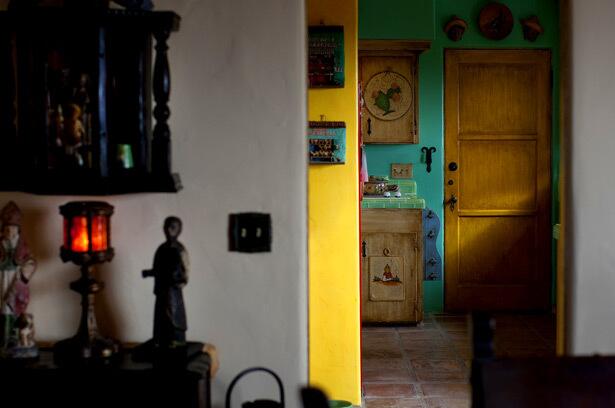
By Lisa Boone, Los Angeles Times
When it came to remaking their Laguna Beach house, Mark and Cindy Evans wanted to create the ambience of the California missions they loved while making room for their favorite pastime: shopping flea markets. The couple call themselves the Flea Marketeers, and their eclectic home now is an entertaining mix of early California Monterey-style furnishings with collections of San Jose and Tlaquepaque pottery, Mexican yard art and their favorite Laguna Beach plein air paintings from the 1920s, ‘30s and ‘40s. Asked if anything in the house is not from a flea market, Cindy jokes, “the bed and the coffee maker.” (Gina Ferazzi / Los Angeles Times)
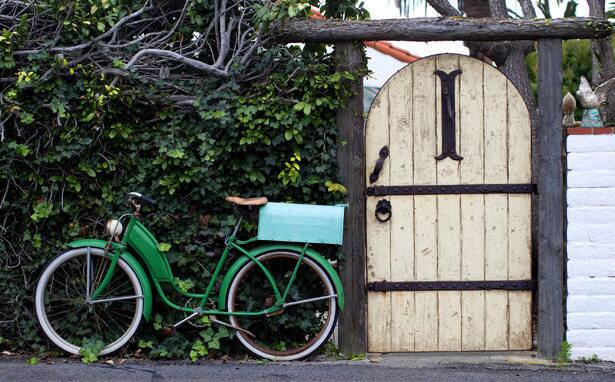
Outside the 1929 Spanish Colonial home, a bright green 1940s bike serves as a mailbox. The couple’s mission-meets-flea-market mash-up has its roots in Mark Evans’ youth. As a teenager growing up in Pico Rivera in the early 1970s, Mark would often hitchhike down to Laguna Beach to explore the picturesque artists colony. “I would marvel at the beauty of the geography,” he says. “But I was just as impressed with the architecture and beauty of the art colony atmosphere. I couldn’t get over the feel of Laguna and its people. It just seemed like they were living in a beautiful art scene that they were appreciating in real time.” (Gina Ferazzi / Los Angeles Times)
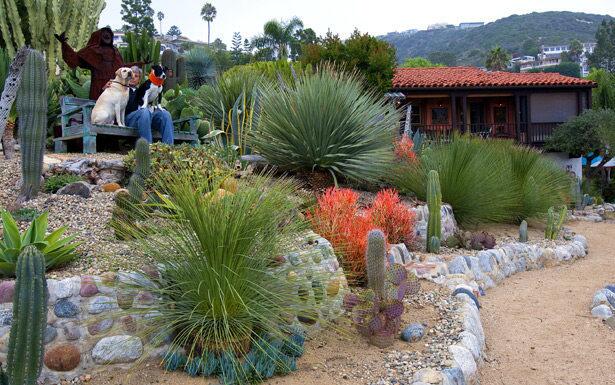
“I love the peaceful feel you get whenever you walk through a mission,” says Mark Evans, pictured here with his dogs. “It is completely different from anywhere else.” In 1999, he and wife Cindy realized their dream of living in Laguna when a rundown Spanish Revival home came on the market. The house came with an interesting history: Architect Aubrey St. Clair designed it for the Bird family, who owned the White House, one of Laguna’s early restaurants. The couple heard that “One Flew Over the Cuckoo’s Nest” author Ken Kesey rented the home at one time, and that fellow counterculture figure Timothy Leary was rumored to have lived across the street. (Gina Ferazzi / Los Angeles Times)
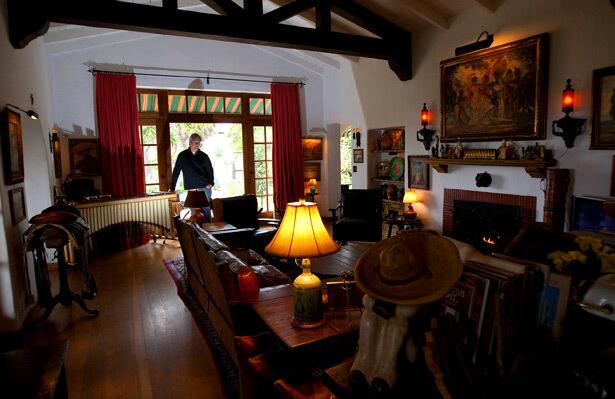
Equally novel was the home’s layout. False walls had been installed throughout the home to create a makeshift boarding house. Most of the rooms appeared to have been partitioned and rented out, including a dining room and balcony where a bathroom had been added. But the house never lost its great bones.
“We removed all of the crazy partitions inside and cleaned every night,” says Mark, who owns a roofing company. Much to his delight, the windows still had the original hardware designed by St. Clair. The house mainly needed fresh paint and the couple’s personal touch. (Gina Ferazzi / Los Angeles Times)
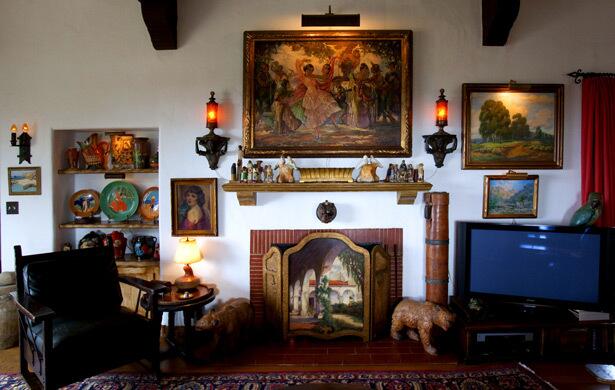
Today, rooms are loaded with concrete revival statues, Dia de los Muertos figurines and Mexican serapes and sombreros, but the house doesn’t feel crowded. It is, in fact, quite comfortable and cozy. “You can put your feet up,” Mark Evans says. “I like my house to feel like a den everywhere.” Theodore Jackman’s 1924 painting titled “Santa Barbara Fiesta” hangs over the fireplace. Evans found the painting lodged above a stack of Barbie dolls in an Arizona antique mall. “You have to look up, “ he offers. “Because no one else will ever notice it.” (Gina Ferazzi / Los Angeles Times)
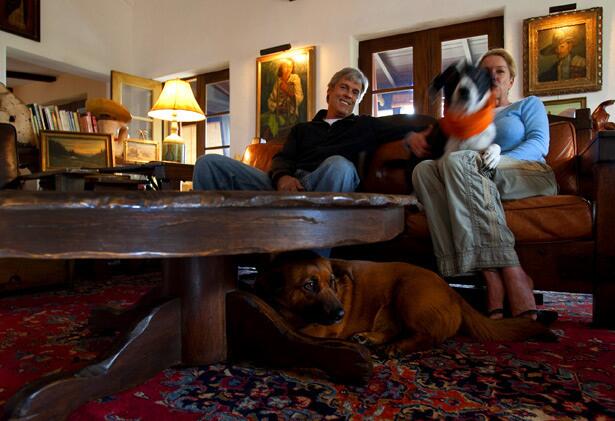
Mark and Cindy Evans in their living room with dogs Maud and Junior. (Gina Ferazzi / Los Angeles Times)
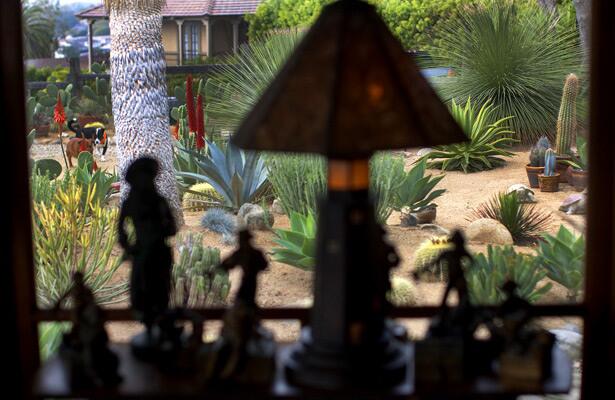
The home’s cozy, airy feel is partly due to the home’s glorious sightlines — views of the ocean and the dramatic garden Mark has cultivated over the years. (Gina Ferazzi / Los Angeles Times)
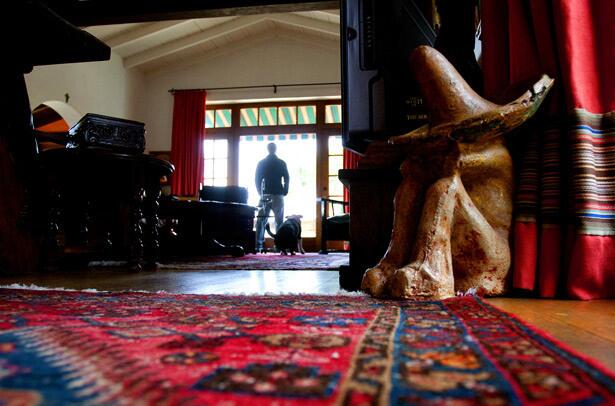
The couple also aimed for a keen sense of balance, a look that is neither 100% stark and dark nor overly exuberant with color or kitsch. A concrete statue from Mexico rests next to the custom drapes that Mark’s sister designed. He has placed a moratorium on any further statues. He jokingly tells his wife: “They are breaking my back, Cindy.” (Gina Ferazzi / Los Angeles Times)
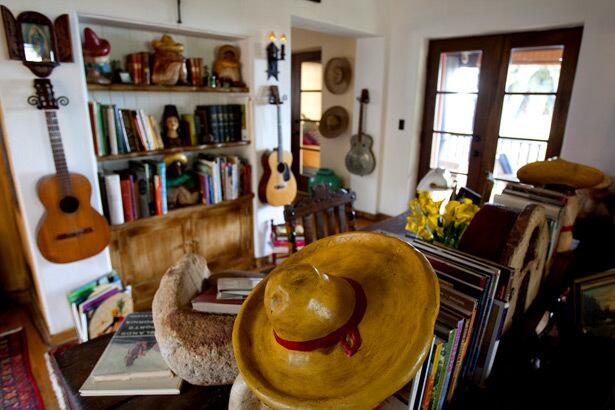
“It’s so fun. It’s like fishing,” Mark says of their antiquing. “And we can always trade out. Flea market vendors are precious people that you get to know over the years. Most of them have a particular area of expertise, and they usually don’t mind telling you the story behind their offerings.” (Gina Ferazzi / Los Angeles Times)
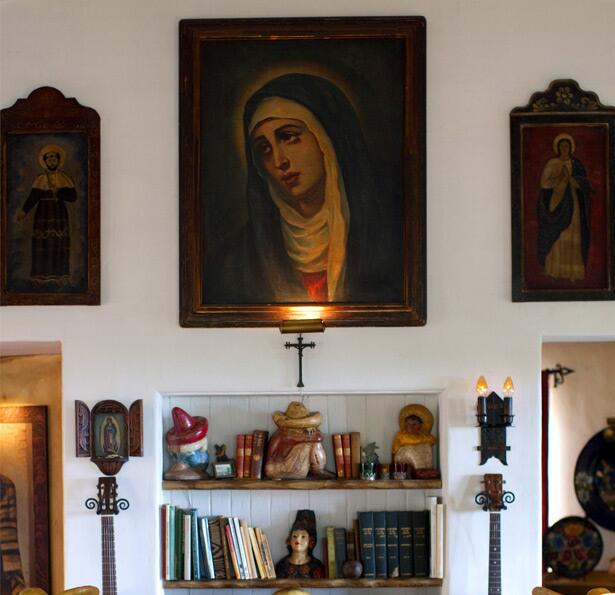
“Doesn’t everyone need a 3-foot-tall painting of the Virgin Mary in their house?” Cindy asks. Responds Mark: “Marys are never very pretty. We bought that one at the Long Beach flea market because she is good-looking.” They purchased the painting not knowing where it would go in the house. “We buy things because we love them,” Mark says. (Gina Ferazzi / Los Angeles Times)
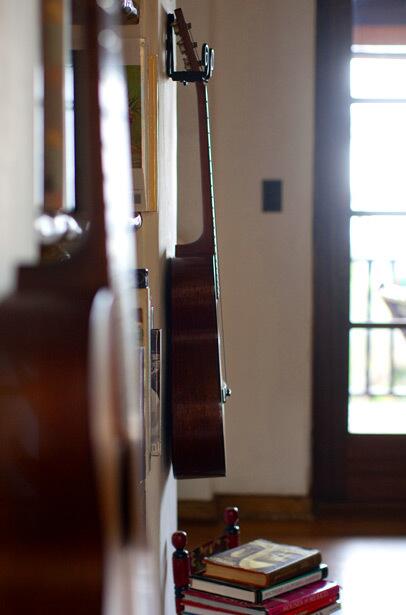
An antique guitar found at a local swap meet hangs in the living room. (Gina Ferazzi / Los Angeles Times)
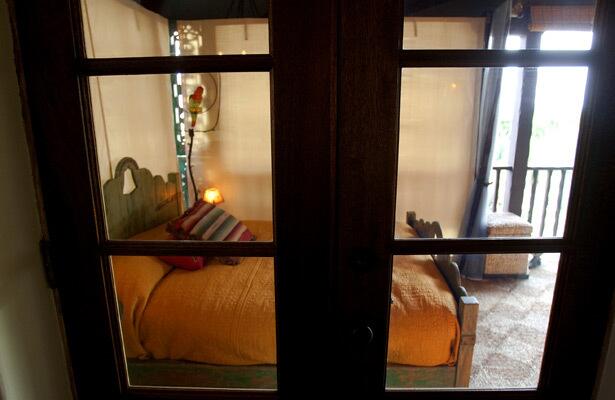
Inspired by an episode of Huell Howser’s TV travelogue “California’s Gold,” the couple recently transformed their balcony into a sleeping porch. They had Blinn & Young, a Costa Mesa maker of custom boating covers and building awnings, construct canvas blinds and mosquito netting to separate the sleeping area from the rest of the balcony. The bed, with bell on the headboard, is from the Grove antique market in Irvine. The balcony also features a sitting area where the couple can see Santa Catalina Island on a clear day or watch the sun set. (Gina Ferazzi / Los Angeles Times)
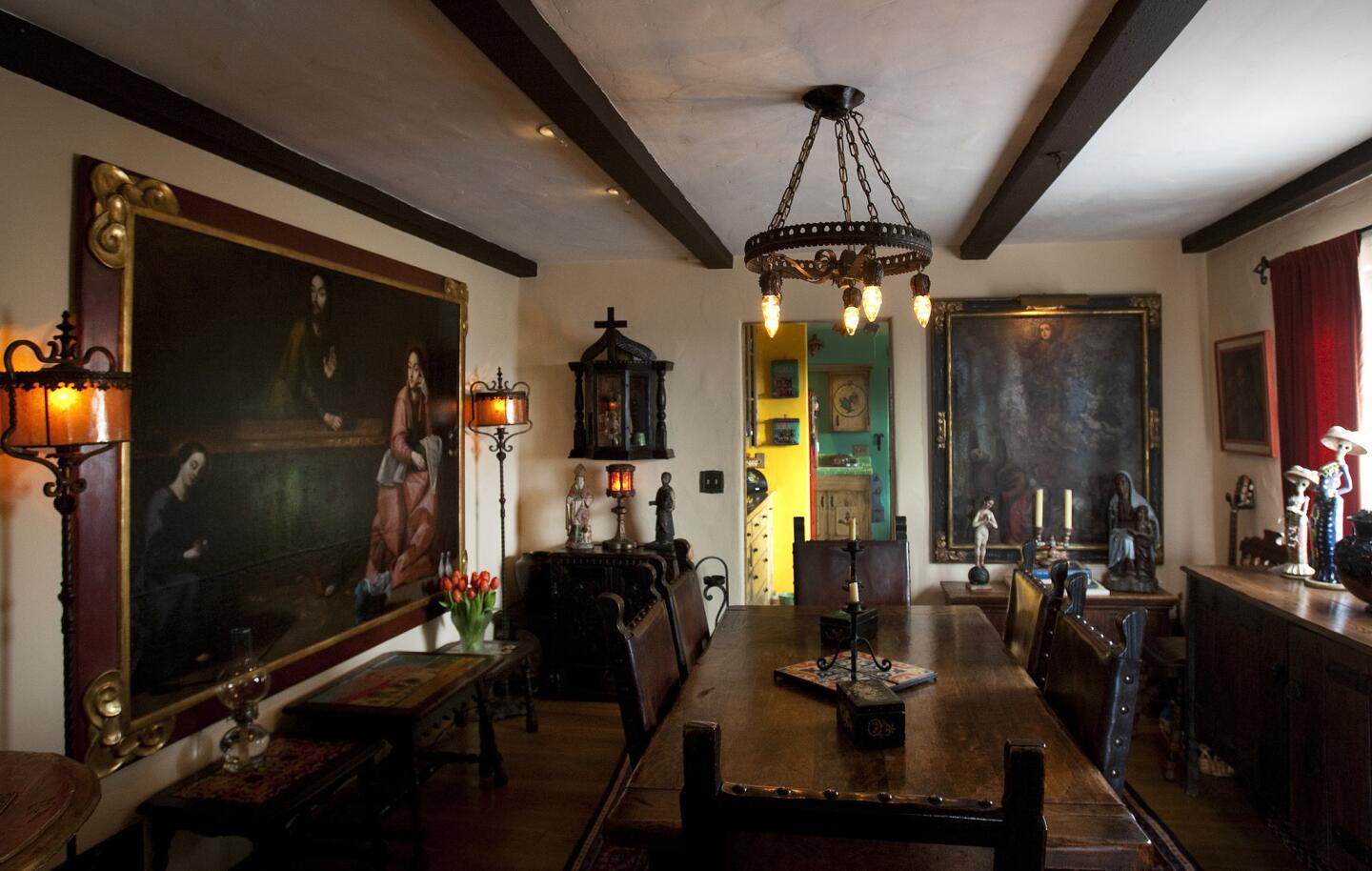
The house’s irreverent mix is on full display in the dining room. A Monterey table is flanked by an 18th century painting of Mary, Joseph and Jesus on one side, and Day of the Dead figurines on the other. On the far wall, left, a “black Jesus” folk art piece hangs with cross from Santa Fe. “We call it the Jesus bar,” Mark says with a laugh, because alcohol happens to be stored in the cabinet below. The yellow and green walls in the distance signal a different decorating mood in the kitchen. (Gina Ferazzi / Los Angeles Times)
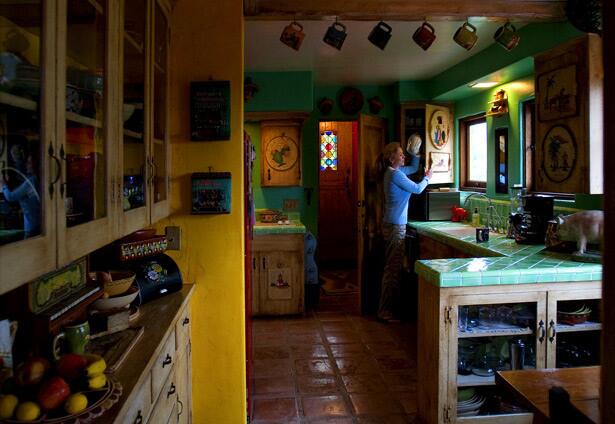
The kitchen is a warm and delightful hommage to Cindy’s Mexican grandmother: green ceramic tile counters, bright red refrigerator, Mexican pavers and colorful Mexican pottery. Among the surprises: beer trays from the 1940s nailed to some of the cabinet fronts. (Gina Ferazzi / Los Angeles Times)
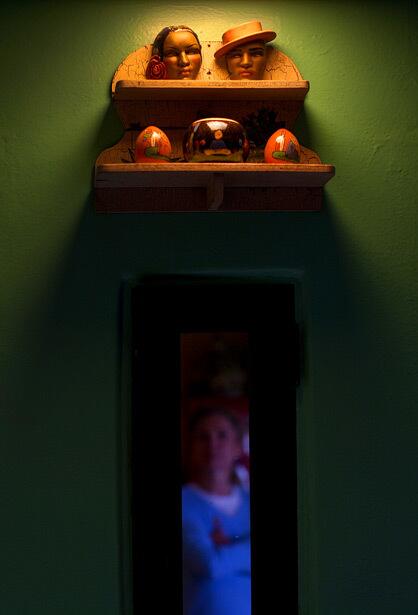
Tlaquepaque pottery and egg-shaped salt and pepper shakers rest on a curio shelf in the kitchen. (Gina Ferazzi / Los Angeles Times)
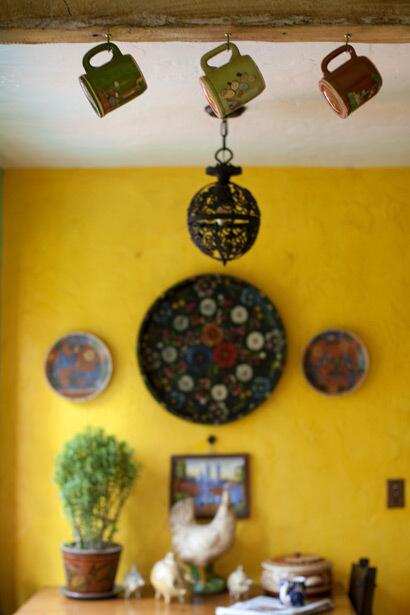
Mugs hang from a ceiling beam. Says Mark of the couple’s collections: “We are constantly moving things around.” (Gina Ferazzi / Los Angeles Times)
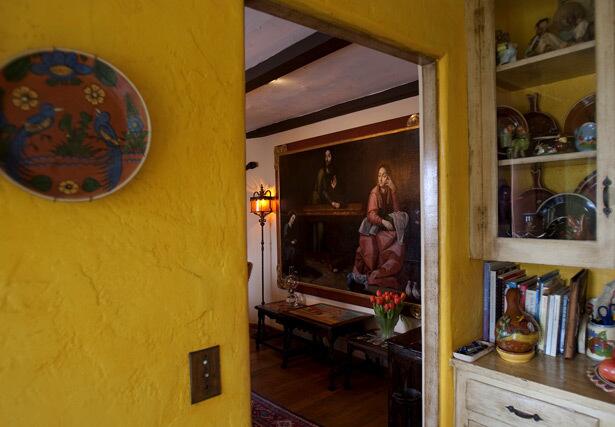
The view looking back toward the dining room. The couple found the 18th century painting in a Sebastapol, Calif., antique store. “The dealer actually had it in his carport,” Mark says. The couple took the painting, which was damaged and torn, to a conservator in Santa Barbara. “I love that Joseph is yelling at Jesus to keep his hands off his tools,” Mark says. (Gina Ferazzi / Los Angeles Times)
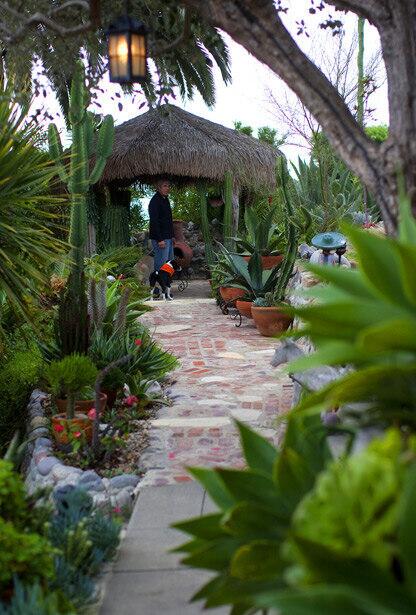
Mark was determined to carry the mission-meets-flea-market mix into the garden. After they purchased the house, the couple filled 12 large garbage bins with brush and debris, leveled off certain areas, installed irrigation and drainage, and rebuilt the terraces, he says. Then he planted drought-tolerant cactus and succulents, partly for fire prevention. (Gina Ferazzi / Los Angeles Times)
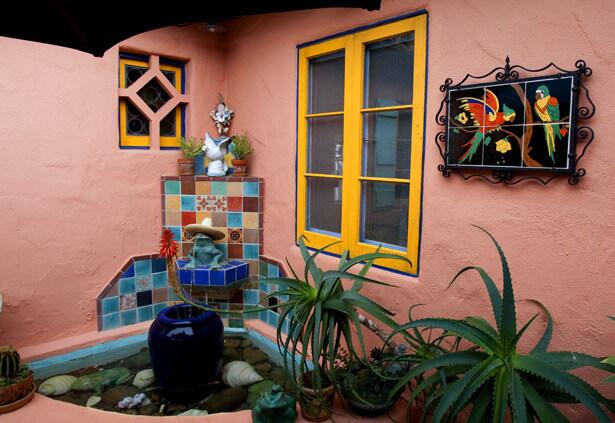
Much to their delight, the 1929 home’s original Malibu tile fountain was left intact in the courtyard. Mark outfitted the frog with a sombrero and added the Bauer Pottery oil jar. (Gina Ferazzi / Los Angeles Times)
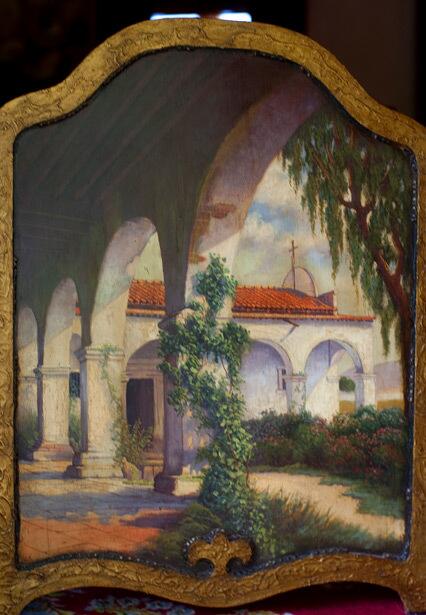
The Evanses’ latest find from the Long Beach flea market: a wooden fireplace screen depicting Mission San Juan Capistrano. (Gina Ferazzi / Los Angeles Times)
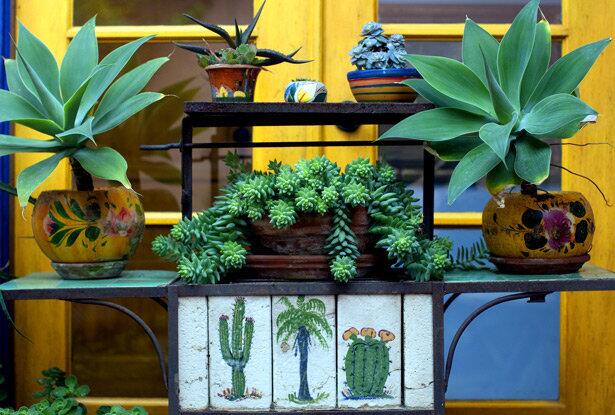
An old barbecue from the 1940s serves as a planter shelf in the Evanses’ courtyard. After 11 years, the garden and house appear done, but do the Flea Marketeers consider their work over? Answers Mark: “We’ll never be done.”
Home tours: More California homes in pictures.
Set Pieces: Our regular feature on TV and film design.
Garden:: The West’s best reporting on sustainable landscaping. (Gina Ferazzi / Los Angeles Times)
Nov. 5, 2024